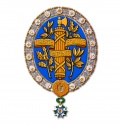Fléville: Difference between revisions
Jump to navigation
Jump to search
Knorrepoes (talk | contribs) m (Text replacement - "|'''English''' ↵| {{blazon wanted}}" to "|'''English''' | blazon wanted") |
Knorrepoes (talk | contribs) m (Text replacement - "{{fr1}}" to "{{fr}}") |
||
| Line 26: | Line 26: | ||
[[Civic Heraldry Literature - France|'''Literature''']]: Image from http://www.armorialdefrance.fr | [[Civic Heraldry Literature - France|'''Literature''']]: Image from http://www.armorialdefrance.fr | ||
{{ | {{fr}} | ||
{{media1}} | {{media1}} | ||
Revision as of 08:44, 25 July 2023
FLÉVILLE
Département : Ardennes
| French | Vairé d'azur et d'argent à l'écusson d'or chargé d'une bermudienne des montagnes (Sisyrinchium montanum) de pourpre, tigée et feuillée de sinople, boutonnée d'or. |
| English | blazon wanted |
Origin/meaning
The arms were officially adopted in 2003.
The field of vair is derived from arms seen in the Fléville Castle, which is now destroyed. A similar field was adopted by the 16th Infantry Regiment of the US Army after the First World War, when they were in Fléville.
The inescutcheon shows a sprig of American blue-eyed-grass, which was imported into the region in 1917/1918 by the fodder of the horses of the 16th Infantry Regiment.
Literature: Image from http://www.armorialdefrance.fr
French heraldry portal
This page is part of the French heraldry portal |
Heraldry of the World |
|
French heraldry:
Overseas territories:
|
Selected collector's items from France:
|


